Resources
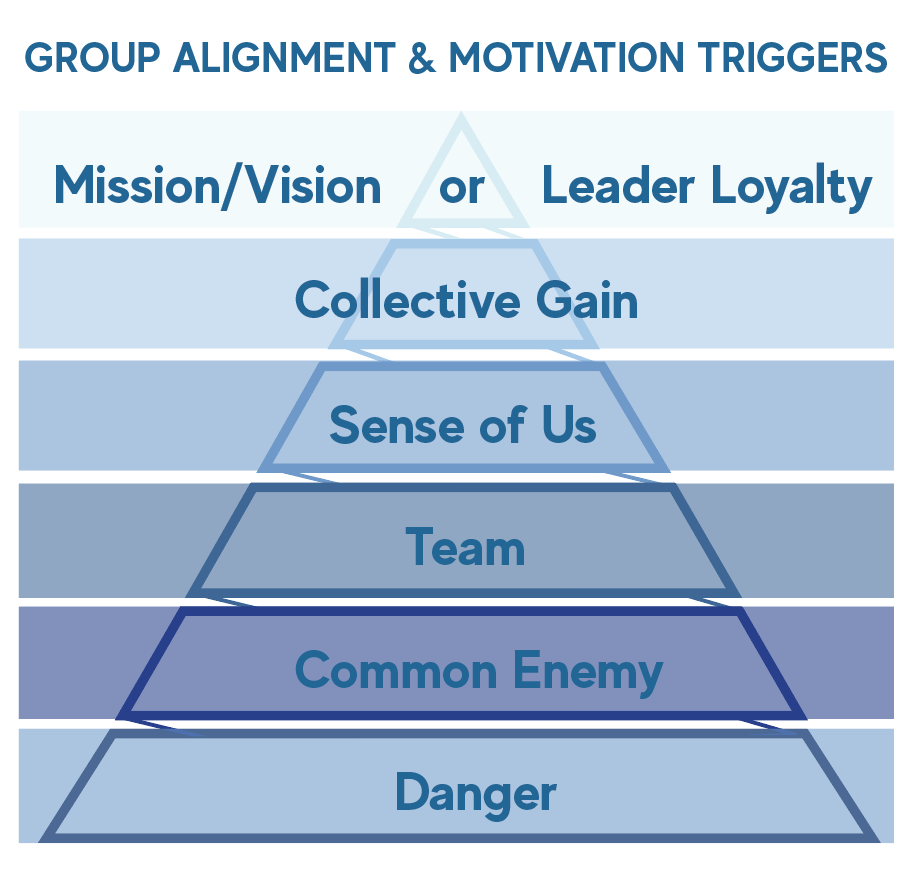
Six Triggers Bring People Together In Almost Any Setting
Six powerful triggers can help people in any setting create alignment within a group or between groups.
More
Nurturing Your Baby's Brain
The first three years of life are key to the brain development for every child. Parents can strengthen their baby's brain in the first years of life by exercising the brain. See this video to learn how to strengthen brains.
More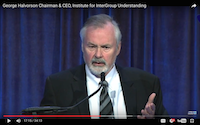
Diversity Inc. — Poverty Vaccine: Reading to Children Before Age 3
"Halvorson is passionate about helping give children from all groups and socioeconomic levels a fair chance at succeeding in life, and he sees early intervention as the best remedy, with the medicine being as simple as exposure to books and reading." — Eve Tahmincioglu

Decoding the Nonverbal Language of Babies
In October 2018, AEI hosted an event examining the importance of nonverbal interactions between mothers and infants. Following an introduction by AEI’s Katharine B. Stevens and First 5 California’s George Halvorson, Beatrice Beebe of Columbia University shared her pioneering research that uses video microanalysis to observe and analyze mother-infant nonverbal interactions.
Please join AEI for Dr. Beebe’s presentation on her pioneering research.
More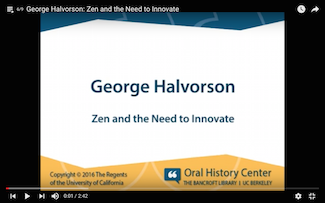
Zen and the Need to Innovate
This piece discusses a process of teaching that involves both helping the student get ready, and then appearing in the right way at the right time to provide maximum value for the student. It teaches the mantra — Each Thing In Its Turn — Each Thing In Its Time. That process and mantra are discussed in both The Art of InterGroup Peace book and in Peace in Our Time.
More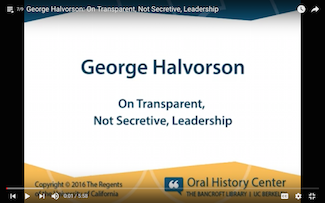
George Halvorson on Transparent, Non-secretive Leadership
In this section of the Berkeley history department interview, Halvorson talks about the tactic and strategy of not having appearance differences serve as a barrier to people’s acceptance of messages and information from others. He talks about being able to do various, relatively revolutionary, things in an industry, by appearing visually as an “Us” for each setting. Similar to The Art of InterGroup Peace book chapter on culture-building tools and processes, and to the Primal Pathways book perceptions of “Us” and “Them” at instinctive levels.
More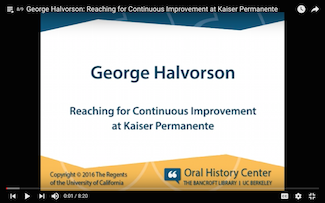
Reaching for Continuous Improvement at Kaiser Permanente
In this interview, Halvorson discusses the value of a plan-based process, and a clear, explicit, and strategic agenda as a leader of a large organization — with particular focus on the strategic and operational value of developing and implementing a robust long-range plan that identifies all key goals and all key strategies as a single process. In the health care world, that package of strategies included implementing a world-class electronic medical record, improving quality, establishing good relations with the relevant partners, and building a diverse and effective leadership team. The piece and process has echoes in both the Primal Pathways book and in the book, Peace in Our Time.
More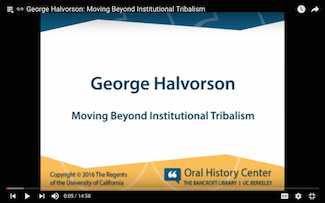
Moving Beyond Institutional Tribalism
In this interview, Halvorson discusses his training and learning process relative to building intergroup Peace, and to setting up and maintaining successful intergroup interactions in multiple settings. Points made in this excerpt are echoed in Primal Pathways, The Art of InterGroup Peace, and Peace in our time. The tribal instincts and intergroup instincts that he looked at in this piece also have strong echoes and case study references in the book Cusp of Chaos. Halvorson also shares some thoughts about the training and personal learning value of his functional roles in health care reform, and in working with public health initiatives and cultures internationally.
More
The Bancroft Library: An Interview with George Halvorson for the Historical Record
Listen as George Halvorson presents substantive additions to the historical record for the Regional Oral History Office of the Bancroft Library at the University of California, Berkeley.
George Halvorson has led an extraordinary life that is filled with accomplishment, introspection and leadership. These tapes beautifully capture what he did, but what’s especially riveting is how he did it. In listening to the complete set, you come away with nothing but admiration for the sheer magnitude of what this curious and self-aware but personally modest man has accomplished.
More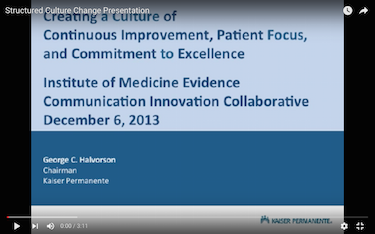
Presentation Made to the Institute of Medicine About Structured Culture Change in Large Health Care Organizations
Cultures tell us in any given setting what we should do, what we should not do, and why we should do or don’t do what we do — “what,” “should,” and “why” anchor cultures.
More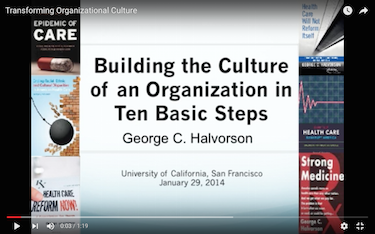
Transforming Organizational Culture in Systematic Ways — A Lecture to the University of California in San Francisco (UCSF Deans Lecture)
The culture of excellence results in solid performance, with number one ratings for Medicare, J.D. Power & Associates, SatmetrixConsumer Survey, and 29 top HEDIS scores ...
More
This information should be shared with all new parents
Three Key Years: Parenting Tips -- Success for Every Child
Education does not begin at Kindergarten. Education actually begins at birth. The first months and years of life are extremely important parts of the education and development process for each child.
More
Halvorson Slides for The Association of African American Superintendents' Annual Meeting
Please click the link above, or the "More" button below to view George C. Halvorson's Slides for The Association of African American Superintendents' Annual Meeting.
More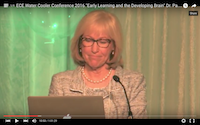
Early Learning and the Developing Brain
Please click "More" or the link above to view the video of Dr. Patricia K. Kuhl, Co-Director, Institute for Learning & Brain Sciences & Bezos Family Foundation Endowed Chair of Early Childhood Education, University of Washington at the 8th Annual Early Learning Water Cooler Conference hosted by Advancement Project.
More
The Gift of Walking

Everybody Walk
“Walking has a huge impact. It makes people healthier. It makes medications work better. It makes people happier. And the effects are immediate — you’ll feel better after a few months of walking,” notes George Halvorson, former CEO of Kaiser-Permanente, America’s largest integrated health care company.
That’s why Kaiser Permanente launched an initiative in 2007 to encourage walking as a stepping stone to good health — beginning with their 200,000 employees in nine states and then spreading word farther through creative media strategies and support for walking advocacy organizations. Click here to enjoy Funny or Die's recent West Wing-style spoof of the fitness initiative.
More
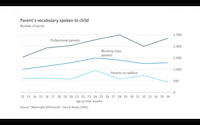
In The Beginning was the Word
The more parents talk to their children, the faster those children’s vocabularies grow and the better their intelligence develops. That might seem blindingly obvious, but it took until 1995 for science to show just how early in life the difference begins to matter.
More
Adverse Childhood Events Create Lifetime Damage
Dr. Harris explains how adverse events in the first years of life have major negative lifetime impacts on children who have them.
More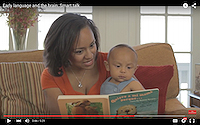
Early Language and the Brain: Smart Talk
"The more parents talk to their children, the faster those children’s vocabularies grow and the better their intelligence develops. That might seem blindingly obvious, but it took until 1995 for science to show just how early in life the difference begins to matter. A close correlation has been found between the number of words a child’s parents had spoken to him by the time he was three and his academic success at the age of nine. At three, children born into professional families had heard 30m more words than those from a poorer background," ~ The Economist
More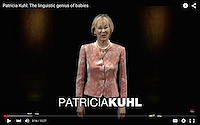
Patricia Kuhl — The Linguistic Genius of Babies
Endowed Chair of the Bezos Family Foundation for Early Childhood Learning, Co-Director at the UW Institute for Learning and Brain Sciences, Director of the NSF Science of Learning Center (LIFE), and Professor at the Department of Speech & Hearing Sciences Patricia Kuhl and her team have done spectacular research into the very early learning times for infants and children. Everyone interested in helping children should know what she and her team have learned.
More
New Medical Science is Teaching Us About The Essential Impact of The First Weeks, Months, and Years of Life For Each Child
We can have a huge impact on the lives of our children in ways that were not well understood until very recently.
New medical science is teaching us that the first three months of life and the first three years of life have massive impact on the lives of children. Read more at The Huffington Post>>
More
Not Teaching Parents About Early Brain Development Is A Massive and Damaging Public Health Failure
The biggest single public health deficit and failure in America today is the fact that almost no parents of newborn children have been told or taught that they can improve their child's learning abilities significantly by exercising their baby's brain in the first three years of life.
The basic biological science on that issue is absolutely clear -- and almost no one is sharing that information about that biology in any useful ways with the parents of newborn children. Read more at The Huffington Post>>
More
Read/Talk/Sing — To Build Strong Brains in Very Young Children
That can be a million dollar gift for a child.
Thirty minutes a day of reading can determine whether or not a child can read or not read -- and that interaction can determine whether a child will stay in school or not stay in school.
Reading is a great thing to do.
Talking to each child makes the child's brain very strong as well.
Simply watching television does not strengthen any child's brain.
Unfortunately, television can entertain -- but it does not make the brain grow. Read more at The Huffington Post>>
More
A Million Dollar Opportunity for Mothers
Brains are strengthened in the first three years of life. Those first three years give us a golden opportunity to strengthen the brain of each child.
The children whose brains are strengthened by having their mother or other people read to them and talk to them every day from birth on are far less likely to drop out of school.
Those children who get those brain-strengthening experiences in those first three years are also significantly less likely to go to jail. Read more at The Huffington Post>>
More
The Time to Strengthen the Brains of Our Children Is Now — Share That Information With Mothers and Families
Most people do not know how important the first three years of life are for the brain development of each child.
Many people believe that kindergarten is the time when the education process begins.
Those people are wrong. The process starts with birth. Brain strengthening and learning ability development literally start at birth. The first few years are critically important -- and we can now predict with a significant degree of accuracy by age three which children will not be able to read when they get to school. Read more at The Huffington Post>>
More
Kindergarten Is Too Late
Kindergarten is too late for a lot of children. That is a sad but biologically accurate fact of life. The basic and most important mental development processes that are needed to help each child read, stay in school, and stay out of prison actually happen before the age of five.
The golden years for strengthening each child's brain are the first three years of life. Children whose brains don't receive the right strengthening support in those first years of life tend to be poor readers.
Children who are poorly prepared and who are poor readers are 40 percent more likely to get pregnant, 60 percent more likely to drop out of school and 70 percent more likely to go to jail. Read more at The Huffington Post>>
More
Brains Are Strengthened in the First Three Years of Life
We have more people in prison in this country than any other country in the world. On a per capita basis, we imprison more than three times as many people as any other western country. Only Russia comes close to us in the number of prisoners per 1,000 citizens, and we significantly exceed them.
When you look to see who is in our prisons, a couple of facts about who we imprison are glaringly obvious. We imprison far more of our minority citizens than our white citizens. That set of facts is well known.
What isn't well known is another extremely important but almost entirely invisible fact about our prisoners. Read more at The Huffington Post>>
More